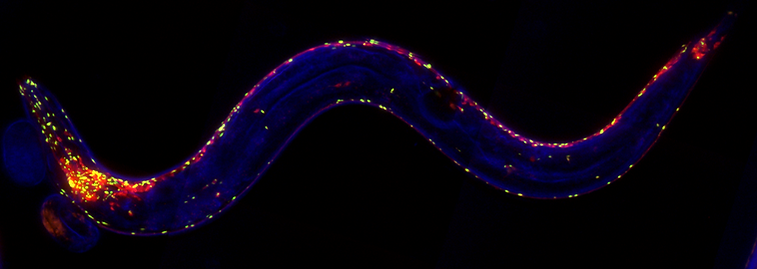
Rice Institute for Biomedical Research
Department of Molecular Biosciences
Northwestern University

Overview of Research

Some of the many questions that interest us:
-
To understand how the metazoan heat shock response and HSF-1 are regulated in different tissues and in response to diverse cell stress conditions, during aging and in diseases.
-
To understand the cellular and organismal strategy of the heat shock response, alone and when coordinated with other cell stress responses such as the organellar unfolded protein responses, the anti-oxidant stress response and with DAF-16/FOX-O.
-
To understand how HSF-1 regulated during non-stress conditions such as development into adulthood and aging?
-
In metazoans, to understand the structure and composition of the stress response network that communicates between tissues; for example the neuronal control of the heat shock response through serotonergic signaling to non-neuronal tissues, from the germline stem cells to the soma, from the fertilized egg to the soma and between muscle and intestinal to neurons.
-
To understand how the proteostasis network monitors the flux of protein synthesis and degradation to distinguish among the distinct folded states on-pathway towards function and off-pathway intermediates that lead to proteotoxicity?
-
To understand how the proteostasis network engages with other cellular and organismal pathways to distinguish diverse forms of cell stress and to respond appropriately to diverse forms of acute and chronic stress during development and aging?
-
To understand the mechanisms underlying programmed control of proteostasis collapse in aging as a strategy to develop approaches to restore cell stress responses and proteostasis for healthy aging.
-
To characterize a small molecule proteostasis regulator strategy to restore the heat shock response in aging that can be directed towards Alzheimer’s disease and Alzheimer’s related diseases and protein conformational diseases generally.

The PROTEOSTASIS NETWORK (PN) regulates protein synthesis, folding, assembly, translocation and degradation and is composed of ~2,000 genes essential for protein quality control in development and longevity, and for organismal health and stress resilience. For metazoans, ORGANISMAL PROTEOSTASIS involves complex intertissue signaling and cell non-autonomous regulation to integrate multiple cell stress responses including THE HEAT SHOCK RESPONSE across tissues to sense, respond and coordinate organismal exposure to a diverse forms of environmental and physiological stress.
The PROTEOSTASIS NETWORK, under ideal cellular conditions through reproduction, maintains flux balance for protein synthesis, folding, translocation and degradation, and therefore is essential for cell and tissue health and organismal longevity. The failure of proteostasis, referred to as PROTEOSTASIS COLLAPSE IN AGING AND NEURODEGENERATIVE DISEASES is associated with proteotoxicity, cellular dysfunction and cell death in neurodegenerative diseases including Alzheimer’s disease, ALS, Huntington’s disease, Parkinson’s disease, and other age-associated diseases including cancer, muscle wasting and metabolic diseases.
To address these questions, we employ multiple model systems and approaches. Much of our research employs C. elegans which has been our discovery tool for ORGANISMAL PROTEOSTASIS. Through the use of genetic screens and experiments designed to test hypotheses on tissue communication, we have shown that the organismal heat shock response is regulated by neuronal signaling, and that the regulation of the PROTEOSTASIS NETWORK involves intertissue communication. The ability to direct cell stress responses between tissues confers a protective mechanism to localized cell stress and tissue-specific expression of highly aggregation-prone proteins. The HEAT SHOCK RESPONSE, for example, while cell autonomous in mammalian tissue culture cells, is regulated cell non-autonomously for ORGANISMAL PROTEOSTASIS. This was shown in C. elegans that the AFD neurons through serotonergic signaling regulates the organismal heat shock response. Neuronal signaling across the synaptic junction to body wall muscle cells regulated by cholinergic and GABAergic signaling across the synaptic junction controls HSF-1 activity and proteostasis in the post-synaptic muscle cells. Moreover, in muscle cells chronically expressing a misfolded protein, proteostasis was restored by transcellular chaperone signaling from distal tissues including neurons and intestine that restored muscle proteostasis to suppress misfolding. Discovery in C. elegans is complemented by the use of mammalian tissue culture cells and patient derived direct-differentiated induced neurons to assess the effects of Tau, mutant SOD1, and mutant Huntingtin on the functional properties of the PROTEOSTASIS NETWORK and to test SMALL MOLECULE PROTEOSTASIS REGULATORS.
Directly related directly to PROTEOSTASIS COLLAPSE IN AGING AND NEURODEGENERATIVE DISEASES, we observed that multiple metastable proteins with the properties of temperature-sensitive mutations misfold shortly after the onset of adulthood. This decline in proteostasis capacity in aging is due to a decline in the HEAT SHOCK RESPONSE at reproductive maturity by germline signaling to the soma by the placement of repressive H3K27me3 chromatin marks at heat shock gene loci, thus blunting substantially the HEAT SHOCK RESPONSE and organismal stress resilience. This relationship between organismal reproduction and proteostasis is observed by communication from the extracellular vitelline layer of the fertilized embryo to the vulva to trigger a parental protective response dependent upon DAF-16, and HSF-1 in somatic tissues, which together restore organismal stress resilience. These observations lead us to propose that the events of aging are programmed and directly relevant to the stability and functionality of the proteome and cellular stress resilience, and that reproduction and health of progeny have a strong influence on organismal stress resilience and proteostasis.
Because of the central role of proteostasis decline in aging to human degenerative diseases that affect nearly all tissues, we have devoted much interest to the development of SMALL MOLECULE PROTEOSTASIS REGULATORS to modulate the HEAT SHOCK RESPONSE, molecular chaperones and other cell stress responses of the proteostasis network to suppress and restore cellular function and suppress protein aggregation. By using C. elegans and patient-derived direct differentiated induced neurons expressing PolyQ, Tau, Ataxin-1 and other disease-associated proteins, we are testing a wide-range of small molecules that affect different arms of the PROTEOSTASIS NETWORK to understand which combinations of proteostasis regulators are efficacious.


